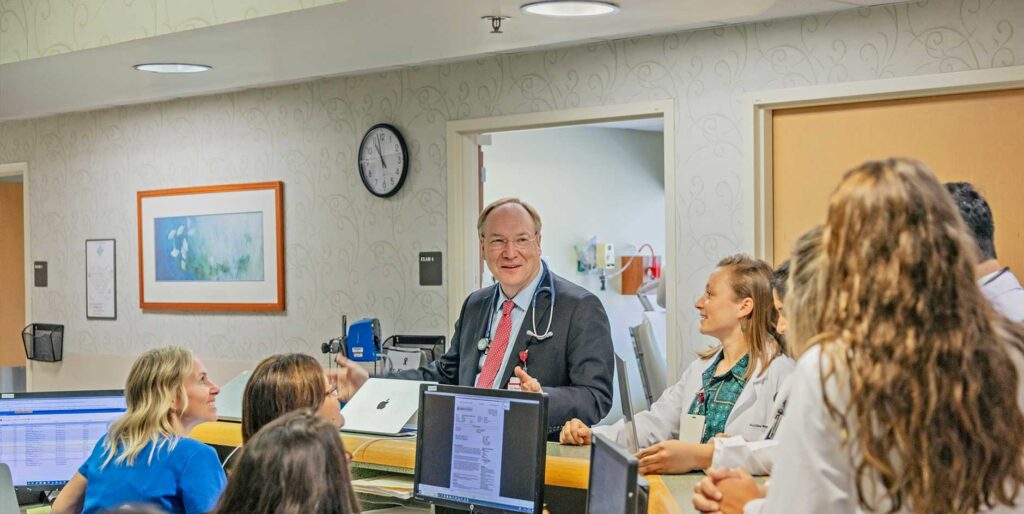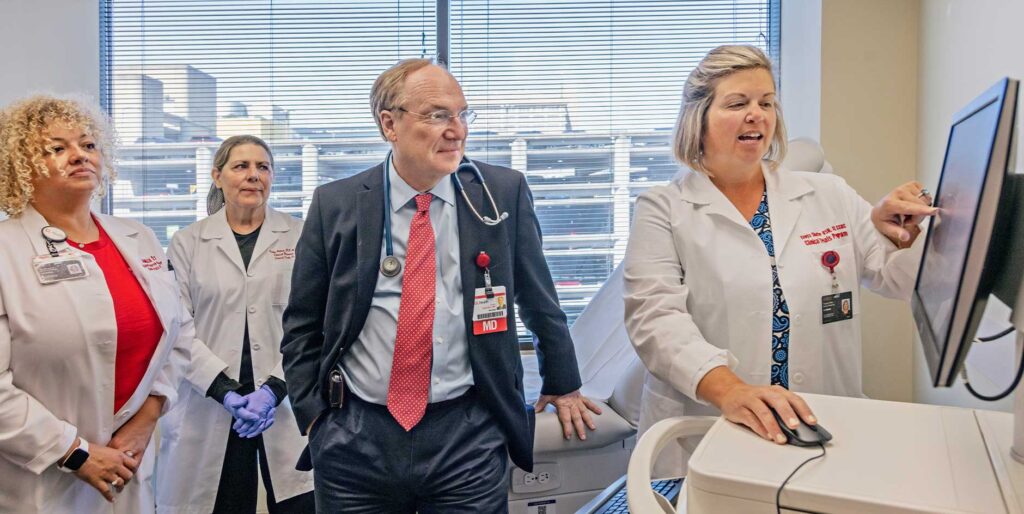UofL Health’s Goetz Kloecker, MD, has seen significant advancements in lung cancer treatment over the past 30 years
LOUISVILLE For Goetz Kloecker, MD, taking the easy route is not his style. If it was, he wouldn’t have chosen to specialize in thoracic oncology. He might not have even come to the United States from Germany 30 years ago. But growing up in Munich, Germany, the son of two physicians, he was always focused on helping people.
Kloecker’s medical journey began with completing his undergraduate work at the University of Regensburg in Regensburg, Germany, in 1986 and then obtaining his medical degree from the Technical University of Munich in 1990. That training also included time spent in Louisville as a senior medical student exchange.
“When I first came to the United States in the 1980s, it was for several months to get practical experience,” says Kloecker, who is the director of thoracic oncology at the UofL Health – Brown Cancer Center. “German medical training had been theoretically very good but practically somewhat limited. The strength of American medical training is the combination of bedside and book and interaction with the professor. Germany was mainly book learning and testing. So, I came here to get the practical aspect. Then later, in the 1990s, I came to become a teacher myself.”
Kloecker returned to the U.S. in 1994 to learn how to structure a residency program. He intended to go back to Germany, but he met his wife, Mary Barry, MD, in Louisville, so he stayed. He completed an internship in internal medicine in 1995, followed by an internal medicine residency in 1997, both at UofL..
For three years Kloecker practiced general internal medicine, primarily in the rural areas close to Louisville.
“When I was out in the community, I saw so much cancer in Kentucky,” says Kloecker. “At that time, it was not easy to find oncologists, especially in the rural areas, so I had to do a lot as a primary care physician – diagnosis, pain control, palliative care, and direct where the patient went to get treated for cancer. When I started doing this in the community, I realized that this was a big problem.”
Seeing the need, Kloecker became interested in oncology, though he was well aware of the challenges it presented. When the Brown Cancer Center invited him to come back as a fellow, he jumped at the chance.

“I knew lung cancer was so common in Kentucky, and I told them I wanted to take care of lung cancer patients,” says Kloecker. “Back then lung cancer was not a very sexy field. There was not much to offer. It was sometimes very sad because for many years, even decades, we had a limited number of treatment modalities. But in the last 15 years, things have boomed. Now thoracic oncology has become one of the sexier specialties because you can make a lot of difference in the patients’ lives.”

Discovery and Innovation in Lung Cancer Treatment
What has changed, says Kloecker, is an enhanced genetic understanding of cancer in the past 20 years and the discovery that certain mutations drive cancer cells.
“The EGFR mutation drives up to 10 percent of lung cancers,” says Kloecker. “When we block this mutation, the cancer goes into remission and stops growing, and these remissions can last for a long time. That was the first revelation that we can turn the key of the cancer engine and shut it down. We now have at least 10 mutations that we can shut down with a simple pill.”
On the heels of that breakthrough discovery came another revelation pertaining to the role of the immune system in fighting cancer.
“Roughly 12 years ago, we learned that the immune system can be boosted and can help you put lung cancer in remission,” says Kloecker. “More than that, we can cure the cancer, even if it has spread and is metastatic. By boosting the immune system, we can put many cancers in remission, and people are alive for years and years.”
Kloecker says that smaller but still significant recent advancements include blocking the blood vessels to cancer. Medicines to help control pain and side effects have helped make radiation therapy and chemotherapy more effective and better tolerated. Enhanced diagnostics such as PET scans and MRIs, as well as blood tests to identify cancer genes, are helping to identify cancers in earlier, more treatable stages.
“There was a trial in 2011 where they used CAT scans with very little radiation and no contrast injection and found that you can find lung cancer early in patients at a certain age if they smoked a certain amount,” says Kloecker. “By finding it early, we can cure a lot of patients by using this screening test.”
Lung Cancer in Kentuckiana
In men, 90 percent of lung cancers are related to smoking, versus 80 percent in women. Among the other causes of lung cancer are radon and air pollution. Kloecker notes that nationally the average age for a lung cancer patient is about 70, but in Kentucky, it is closer to 60 due to the higher prevalence of smoking at a younger age.
“In the United States, lung cancer rates have dropped significantly since the 1990s — more than 20 percent,” says Kloecker. “This is because smoking has become less common. We are continuously dropping the incidence rate and the mortality rate. While we are more effective at finding cancer and treating cancer, there is a growing number of lung cancer survivors. So, the total number of lung cancer patients may be the same, or even increasing, because the patients survive their lung cancer longer. The survival rate of metastatic lung cancer has increased from two percent to close to 20 percent. We have fewer new patients and fewer patients dying from lung cancer but far more survivors.”
Thoracic Cancer: The Hot New Specialty
What was once a potentially depressing specialty, thoracic oncology, has grown in popularity as physicians embrace the enhanced opportunity for good outcomes. Kloecker, who is the fellowship program director, teaches graduate students, residents, fellowship, and subspecialty training. It makes for a busy schedule, balancing days in the clinic, conferences with fellows, hospital calls, and studying medical records and clinical trials.
“We have about 300 applicants for our positions here,” says Kloecker. “It’s often because of personal experience — often their family. They realize how serious this is. And it is an intellectual curiosity because in oncology, you have research, technology, genetics, radiology, social sciences — everything comes together.”
That doesn’t mean that every day is a good day, that every outcome is a positive one. The fear and reality of negative outcomes persist.
“Emotionally, it’s a different field from other fields because you see patients who are suffering and their family so close up,” says Kloecker. “It becomes emotionally very challenging. It is hard on fellows to see young people their own age suffering from cancer.”
The Impact of Clinical Trials
Kloecker is optimistic that the suffering will continue to decline as more advancements are made in the prevention, detection, and treatment of thoracic cancers.
“In the next 10 years, I think our survival rates will not only get tenfold higher but probably reach 80 percent,” he says. “We need to send a message out about how important clinical trials are. The sad truth is that only five percent of people in the United States with a bad cancer like lung cancer get enrolled in clinical trials. Patients may think that they are used as guinea pigs. What people have to understand, however, is that clinical trials nowadays are the best chance to survive cancer, because not only do you get the newest treatment, but you also have more people looking at your cancer, your x-rays, and your chart, so you have many more people supporting you.”
Kloecker’s optimism extends to the classroom, where he encourages his students by showing them the amazing advancements in the past 20 years. He shows them a video of the Wright brothers as an example of how quickly a small step can become a giant one.
“I show my students how the Wright brothers hopped with their airplane maybe the length of a football field and then sixty-six years later, we’re landing on the moon,” says Kloecker. “In cancer research, I think our jumps are longer now.”
Cancer Vaccine: The Holy Grail
One potential giant leap for mankind is the possible development of a vaccine for cancer. What might seem unfathomable may not be so far out of reach. “What I’m presently very excited about is a vaccine against cancer,” says Kloecker. “There are now more and more trials where we use the common cancer proteins and we can make a vaccine out of it, inject it — often with immune therapy to boost the immune system — and then hopefully if the patient ever had a cancer, it will not come back. I imagine we may have cancer vaccines like we have now against measles or smallpox. That would be the holy grail of oncology to make cancers disappear altogether.”
In the meantime, Kloecker continues the work he started so many years ago, relying on science and optimism to get him through the bad days. He takes solace in the knowledge that he can help people, even on their worst days.
“There are still a lot of patients with lung cancer in Kentucky, and I know how much we can help them,” says Kloecker. “It’s the same motivation I had when I started — to help people. You learn a lot from the people and from your colleagues, and I think it makes life more valuable and worthwhile.”




